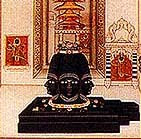Saumitra-II
Saumitra-I
ballad
Culmination
Nadal-ism
कृष्ण की चेतावनी
वर्षों तक वन में घूम-घूम,
बाधा-विघ्नों को चूम-चूम,
सह धूप-घाम, पानी-पत्थर,
पांडव आये कुछ और निखर।
सौभाग्य न सब दिन सोता है,
देखें, आगे क्या होता है।
मैत्री की राह बताने को,
सबको सुमार्ग पर लाने को,
दुर्योधन को समझाने को,
भीषण विध्वंस बचाने को,
भगवान् हस्तिनापुर आये,
पांडव का संदेशा लाये।
‘दो न्याय अगर तो आधा दो,
पर, इसमें भी यदि बाधा हो,
तो दे दो केवल पाँच ग्राम,
रक्खो अपनी धरती तमाम।
हम वहीं खुशी से खायेंगे,
परिजन पर असि न उठायेंगे!
दुर्योधन वह भी दे ना सका,
आशिष समाज की ले न सका,
उलटे, हरि को बाँधने चला,
जो था असाध्य, साधने चला।
जब नाश मनुज पर छाता है,
पहले विवेक मर जाता है।
हरि ने भीषण हुंकार किया,
अपना स्वरूप-विस्तार किया,
डगमग-डगमग दिग्गज डोले,
भगवान् कुपित होकर बोले-
‘जंजीर बढ़ा कर साध मुझे,
हाँ, हाँ दुर्योधन! बाँध मुझे।
यह देख, गगन मुझमें लय है,
यह देख, पवन मुझमें लय है,
मुझमें विलीन झंकार सकल,
मुझमें लय है संसार सकल।
अमरत्व फूलता है मुझमें,
संहार झूलता है मुझमें।
‘उदयाचल मेरा दीप्त भाल,
भूमंडल वक्षस्थल विशाल,
भुज परिधि-बन्ध को घेरे हैं,
मैनाक-मेरु पग मेरे हैं।
दिपते जो ग्रह नक्षत्र निकर,
सब हैं मेरे मुख के अन्दर।
‘दृग हों तो दृश्य अकाण्ड देख,
मुझमें सारा ब्रह्माण्ड देख,
चर-अचर जीव, जग, क्षर-अक्षर,
नश्वर मनुष्य सुरजाति अमर।
शत कोटि सूर्य, शत कोटि चन्द्र,
शत कोटि सरित, सर, सिन्धु मन्द्र।
‘शत कोटि विष्णु, ब्रह्मा, महेश,
शत कोटि विष्णु जलपति, धनेश,
शत कोटि रुद्र, शत कोटि काल,
शत कोटि दण्डधर लोकपाल।
जञ्जीर बढ़ाकर साध इन्हें,
हाँ-हाँ दुर्योधन! बाँध इन्हें।
‘भूलोक, अतल, पाताल देख,
गत और अनागत काल देख,
यह देख जगत का आदि-सृजन,
यह देख, महाभारत का रण,
मृतकों से पटी हुई भू है,
पहचान, इसमें कहाँ तू है।
‘अम्बर में कुन्तल-जाल देख,
पद के नीचे पाताल देख,
मुट्ठी में तीनों काल देख,
मेरा स्वरूप विकराल देख।
सब जन्म मुझी से पाते हैं,
फिर लौट मुझी में आते हैं।
‘जिह्वा से कढ़ती ज्वाल सघन,
साँसों में पाता जन्म पवन,
पड़ जाती मेरी दृष्टि जिधर,
हँसने लगती है सृष्टि उधर!
मैं जभी मूँदता हूँ लोचन,
छा जाता चारों ओर मरण।
‘बाँधने मुझे तो आया है,
जंजीर बड़ी क्या लाया है?
यदि मुझे बाँधना चाहे मन,
पहले तो बाँध अनन्त गगन।
सूने को साध न सकता है,
वह मुझे बाँध कब सकता है?
‘हित-वचन नहीं तूने माना,
मैत्री का मूल्य न पहचाना,
तो ले, मैं भी अब जाता हूँ,
अन्तिम संकल्प सुनाता हूँ।
याचना नहीं, अब रण होगा,
जीवन-जय या कि मरण होगा।
‘टकरायेंगे नक्षत्र-निकर,
बरसेगी भू पर वह्नि प्रखर,
फण शेषनाग का डोलेगा,
विकराल काल मुँह खोलेगा।
दुर्योधन! रण ऐसा होगा।
फिर कभी नहीं जैसा होगा।
‘भाई पर भाई टूटेंगे,
विष-बाण बूँद-से छूटेंगे,
वायस-श्रृगाल सुख लूटेंगे,
सौभाग्य मनुज के फूटेंगे।
आखिर तू भूशायी होगा,
हिंसा का पर, दायी होगा।’
थी सभा सन्न, सब लोग डरे,
चुप थे या थे बेहोश पड़े।
केवल दो नर ना अघाते थे,
धृतराष्ट्र-विदुर सुख पाते थे।
कर जोड़ खड़े प्रमुदित,
निर्भय, दोनों पुकारते थे ‘जय-जय’!
- रामधारी सिंह “दिनकर”
Afridi fell and the match was won.
Near Perfect Pic
Book reading or anything
Why are some books easy to read while others are difficult to complete. Without loss of generality, compare Jeffery archer and Frederick Forsyth or to make my point more clear let us take Sidney Sheldon and Orhan Pamuk. I am not trying to draw these writers into my silly comparisons, but perhaps you would understand the point I am not trying to say. A passing thought is like a shooting star, it ends as soon as it begins, and we are left trying to make sense of it. One passing thought makes me write something like this. Some books are indeed unappealing to us because we are not in a good mood or because we do not like the subject, the story or the style of prose. But I am talking about the ones which we like and still are not able to complete. To many readers, a Jeffery archer book can be completed in one sitting or in maximum two sittings. Why? Because the plot is engaging and keeps their interests alive till the end. It satisfies the curiosity of outer layer of our brain immediately. However reading the book of the other kind becomes a challenge. Understanding what is written, what is emphasized requires more labor. In some way, it is like probing deeper into layers of our brain and trying to prepare a report card for our brain.
The prospect of which brings fatigue within us.
Reading is as much an art as writing. Completing an interesting piece which is difficult may require one to be in a trance, and be switched off to everything else. Like a doped recluse trying something all by himself.
The actual comparison then, is between the different layers of our mind. It is very natural to extend this beyond the subject of book reading. I think it is about the effort required to contrive sync between the task at hand and one layer of our mind. The one which is obvious and strikes rhythm with our outermost layer is most tempting and serves instant understanding. We require more effort to break into a different level of harmonic. I know that what I have said is nothing new, but just that I again wrote about warp and woof of our thought process.

